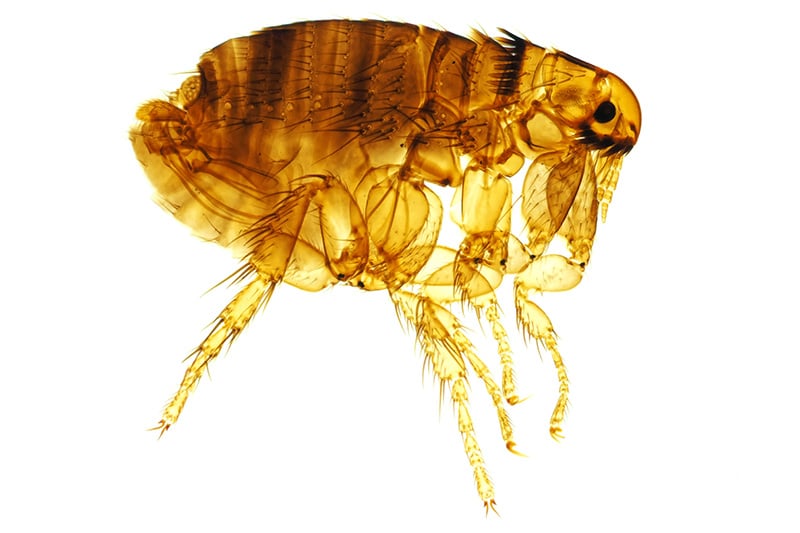
Ctenocephalides Canis or dog fleas are problematic to dogs and their owners. Not only can they be carriers of diseases such as Typhus and Bubonic plague, in dogs they can also cause a variety of health issues like allergic dermatitis, pruritis, anemia etc.
Ctenocephalides Canis in the United States

In the United States, dog fleas pass the cold winter season in the immature state (eggs/larvae). The onset of warmer or rainy seasons brings productive outbreaks of dog fleas while the hot or extreme summer months put a check on their breeding. Dog fleas are more abundant in sandy regions due to optimal moisture content in sand.
What do Ctenocephalides Canis or dog fleas look like?
Physically, the Ctenocephalides Canis measure about 2 to 8mm in length. They have brown, oval bodies and disproportionately small heads.
Dog fleas have 6 legs; the hind ones are capable of jumping long distances. This is how they travel from one host to another. Primarily, they feed only on dogs or cats, but, when excessively numerous, they can be quite troublesome to humans.
Dog flea bites and symptoms

Dog flea bites can cause itchiness or secondary skin infections. The symptoms of Ctenocephalides Canis bites include:
- Itchy, red or swollen welts.
- Lumps that may develop into blisters or wounds.
- Dogs that are hypersensitive to dog fleas may suffer from flea allergic dermatitis or FAD. This can cause intense scratching, self-inflicted trauma as well as patchy hair loss in dogs.
- Pruritis and flea-induced anemia are some other conditions caused by dog fleas.
Preventing and treating Ctenocephalides Canis infestations
The following principles must be used to control Ctenocephalides Canis outbreaks:
- Treating the host dog for adult fleas responsible for producing eggs.
- Clearing out immature stages (larvae/eggs) that may be breeding under the furniture, below the carpets, flooring etc.
Methods to treat dog fleas on the host

- Wash the dog in a tub containing diluted, vet-approved dog shampoos. If the dog has flea bite scabs, make sure that the product used is non-irritating. Allow the pet to remain in this solution for five minutes. Rinse using warm water. As a final rinse, use a diluted apple cider vinegar solution. This will also give a healthy shine to the dog’s coat.
- Rub the fur with powdered naphthalene crystals or moth balls. This method is highly effective in bringing the fleas to the surface of the coat and then you can comb them out. Care must be taken when using this technique, since naphthalene is flammable.
- Pyrethrum powder or baking soda can also be dusted on the dog’s body. This helps deodorize the dog while taking care of dog fleas. Avoid this if the dog has open wounds.
- When using flea powders for treating dog fur, make sure to place old newspapers on the floor, so that when the insects drop down, you can kill them in alcohol or white vinegar. This precaution helps prevent further infestations.
- Apply soothing Aloe Vera or calendula lotion to the scabs and blisters. This helps heal the dog flea bites. Likewise, 3% carbolic acid solution or menthol, camphor and carbolated vaccine can be used for alleviating skin irritation caused by dog fleas.
- For bites on human skin, apply iodine tincture to soothe and disinfect the region.
Treating dog fleas in the immature stages

Once you have dealt with dog fleas on the host animal, it is necessary to get rid of larvae and eggs breeding inside furniture cracks, under the flooring/carpets and other areas where the dog spends time.
- Start by removing the carpets or rugs. Vacuum the area thoroughly.
- Sprinkle diatomaceous earth (DE) powder on the floor and let it remain for a couple of hours. Vacuum the entire area again. DE powder dehydrates the fleas and also shreds their insides.
- For wooden floorboards, scrub the entire flooring with soapsuds.
- Thoroughly air and beat down rugs, bedding and carpets. Treat them with powdered naphthalene.
- Frequently sweep or vacuum the floors to destroy immature stages of Ctenocephalides Canis.
- Catch the adult dog fleas using flea traps. An example of homemade traps: a small lamp set in a pan of water covered with a film of kerosene. This attracts and traps dog fleas.
Dog fleas can cause a great deal of anxiety to dogs and nuisance to owners. Good hygiene practices such as regular cleaning and disinfecting can help lower the risk of further infestations. If needed, a professional pest control company should be consulted to determine the nature and extent of the problem.

